|
World Record Sub-Inch 600-Yard 6BR
Terry Brady's Remarkable Record-Breaking Rifle
Other Guns of the Week >
At the Piedmont, NC, range, two shooters recently broke the 1" mark for the first time in registered 600-yard competition. Shooting a 6.5-284, Wolf Beuhner nailed a .960" group that earned him Piedmont's cash bounty for the first sub-inch group. Shortly thereafter, not to be outdone, Terry Brady eclipsed Wolf's mark with an amazing .860" group--a new IBS world record, pending certification. Terry's stellar .860" five-shot cluster is the equivalent of a 0.1433" group at 100 yards. Terry performed this feat with a "high-mileage" converted 6PPC, shooting a standard 6BR with factory Berger 105s. Terry proved that the "plain-vanilla" 6BR is still more than capable of setting world records. Terry's achievement, with off-the-shelf components in an older rifle, demonstrates just how accurate this cartridge can be. Well done, Mr. Brady!
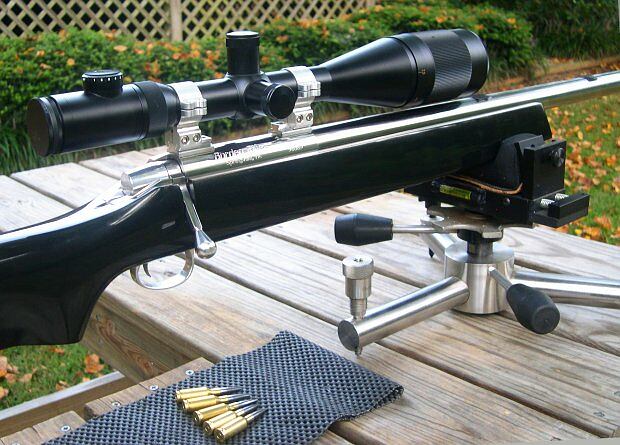
"Simple Country Boy" Makes Good
Like many of the featured shooters on this site, Terry Brady was raised in the country and started shooting as a young boy. He grew up in Cleveland County, North Carolina, near Falston, a "plain old country town" according to Terry. Terry explained: "All the other kids were going out for sports but I was hunting and fishing. I'd been around guns all my life. My first gun was Daddy's old rifle, a Winchester single-shot 22, a model 67 I believe. My momma had a half dozen walnut trees. I remember saving my money to buy a box of 22s so I could shoot the walnuts out of Momma's trees. I guess that got me interested in 'extreme accuracy' at a very young age.
I got started in competitive shooting with Larry Willis' Hickory Groundhog Shoot and one thing lead to another. I heard that the Piedmont Club had 500-yard varmint matches (3-shot groups) so I got involved with that. Now Piedmont runs registered Benchrest matches at 600 yards instead. The competition is more intense, and there are more shooters. But in a way I miss our 500-yard shoots. I think the 500-yard matches were more fun--more laid back, less politics involved. Now we'll get 50-60 shooters, it takes all day to finish a match, and you need very high-quality equipment to be competitive. I've also shot some 200-yard matches with my PPC. But I didn't have the time to shoot both point-blank and 600-yard BR, so I stuck with the 600-yard game. It's taken me some time to develop my skills and get the right rig, but it all came together a few weeks back, during Piedmont's regular 600-yard shoot. I managed to shoot a .860" five-shot group, using my little 6BR in Heavy Gun class. Hopefully this will soon be certified as a new IBS World Record."
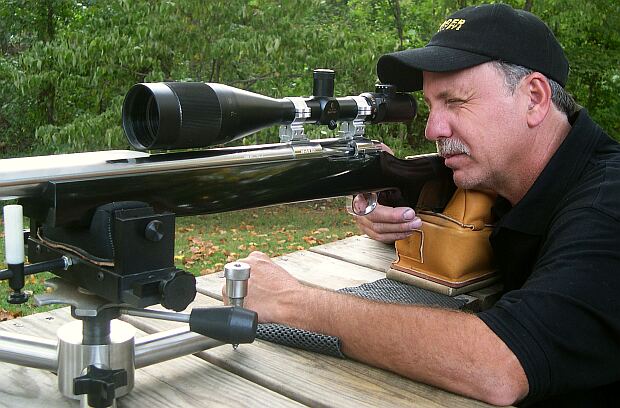
Shooting Sub-Inch at 600 Yards--How It Was Done
Terry told us: "I'd like to say I did something special to shoot that small group, but that wasn't really the case. The conditions were very good--almost no wind, and with my NightForce at 42X I could see bullet holes. I was on the third relay in Heavy Gun, shooting about 10:30 a.m., with temps about 80 degrees. You could still see the target, not much mirage. (Later that day, the mirage kicked in real bad). For the third relay you could still see the number 10 on the target real well and that's what I was holding on. I had 3/8ths MOA of windage in my scope, and held dead center. (We were using skeet clays for sighters and my last shot on the skeet busted right in the middle so I was confident in my zero.) I was just trying to concentrate on holding dead on the 10. The gun was real steady on the bags. I wasn't watching the flags, I just let 'er rip. And they all went there. All five.
It took maybe 20-30 seconds to shoot the string. I was alternating shots with James Phillips, who was on my left. We were shooting in sequence--he'd shoot one, then I'd shoot one. (I didn't want his muzzle blast to disturb my bullets). As this went on, I could see a little wad forming on my target. When I finished I asked James what he thought and he said they looked like a little cluster. The boys then went and got the target. I heard: 'Somebody shot another small one on bench 13.' That was me, 'Lucky 13' I guess. Wolf had already shot his .960" small group at that point. They were saying mine came in between a .850" and a .870"--we'll see what the IBS says eventually. Overall, I'll have to say the gun shot superbly, and I certainly had luck on my side. That day I took five first place trophies."
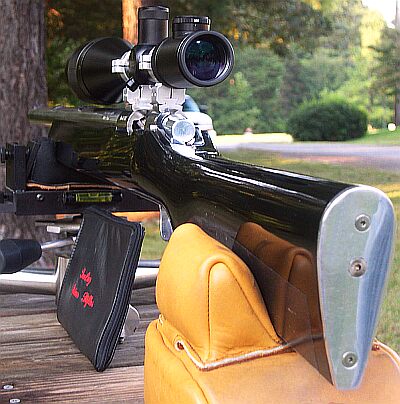 Components and Bench Gear Components and Bench Gear
The record gun was originally built by Jim Borden as a 6PPC with a Hart 20.5" barrel. The action is an early Left Port, Right Bolt "TPE Borden" glued into a black Borden glass BR stock. Terry noted: "With one of my other rifles, I tried a 6x44 similar to the cartridge Joel Kendrick shoots. That shot decent, but not spectacular, and I soon decided that 6x44 case-forming was WAY too much work. So, I took the black rifle to Dave Tooley, and he put on an 8.5-Twist, 28" Krieger 4-groove, chambered in 6mm BR Norma with a .267" neck. The barrel is a Heavy Varmint taper about .94" at the muzzle. With the 28" tube, the rig was nose-heavy, so I added a two-pound plug of solid lead in the rear. Even without a brake, recoil is mild. With a little thumb pressure on the stock, I can see impact on target, and I can even follow the vapor trail when it's humid.
The scope is a 12-42X Nightforce Benchrest model with a varminter style reticle. At some point I plan to change to a simpler target dot reticle. The aluminum rings are from Speedy (S.G.& Y.) and they're really nice. The front rest is a custom unit made by Jeff Ferguson, with a Bald Eagle windage top with ribbed front cordura bag. My current rear bag is leather Protektor with rabbit ears. I used to use the lower 'bunny ear' model, but Wolf suggested I try the taller ears. I did and I think the taller ears stabilize the gun better. On the leather bag I use some graphite to slick it up, while I use silicon on the cordura."
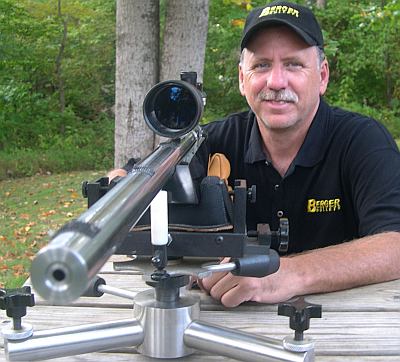 Q and A with Terry Brady Q and A with Terry Brady
Q: Is There an Ideal Cartridge for the 600-yard Game?
A: James Phillips did great with a 22 Dasher, and Joel was Shooter of the Year with his 6x44. But I'm happy with the 6BR. If the conditions are right, that 105 Berger, running over 2850 fps, will do the job.
In fact, it can do surprisingly well even in windy conditions. In one match it was blowing 35 mph, yet I averaged a three-something (inch) group, and finished third in Heavy Gun. The litte BR held its own.
Q: What Do You Like Best about the 6BR?
A: Finding a load is easy, and the low recoil makes the gun easy to shoot. Plus the components available are such high quality. I'm amazed by these 105s. The Berger 105s will bughole at 300 yards if you do your part--a little wad about half an inch. I also like the 6 PPC, but Joel and I saw that it won't run with a 6BR shooting heavy bullets, once you get past 500 yards. When we used to shoot 3-shot groups in varmint matches, the 6 PPC was competitive. But once we went to 5-shots at 600 yards, the PPC groups opened up.
Q: How Low Can This 600-yard Record Go?
A: It will come down. It will take another good day with no wind. I've seen Rich DeSimone put four shots in .75" but throw one. I was just lucky--I've shot a 1.4" group in practice, but 2-2.5" is more typical for this gun at 600 yards. I don't know if the shooter who lowers the record will be a free recoiler or a grabber. I suspect it will be someone who holds the stock. I don't think a PPC can do it. But it could be another 6BR, or a 6.5-284, or one of the in-between calibers.
Q: What's Your Shooting Style with the Black 6BR?
A: I pretty much shoot free recoil, with just a little thumb pressure and no shoulder contact. I don't grip the rear bag, but instead adjust elevation with the front rest. Getting the rest set up right is very important. When I set my front rest down, I'll tap the points in the cement, then I'll line everything up, and lay the gun down. Then I'll work the stock down into the rear bag, making sure it's tracking well.
Q: If you were building a new 600-yard gun from scratch, how would you put it together?
I'd probably go with a BAT action, Krieger 8.5-Twist, 6BR in a Terry Leonard stock or a Tooley MBR. I like the MBR's high cheekpiece--I like to put a little cheek into the stock sometimes. I'd stick with a .267" neck. I don't mind turning case-necks that much. I might try a straight-countour 28" barrel.
Q: Would You Consider Switching to a 6 Dasher or a 6BRX?
A: No, I'm going to stick with what I got. I've got the speed I need. I think 2900 fps is about all that a man needs for the 105s--that's plenty. I'll admit the BRX is interesting, since you can use regular dies, or so they say. But overall, I don't think you need an improved case to do real well at 600 yards.
Q: What About the 6x44?
A: Nope, I tried that. It's just too much work. I'm a lazy man. Plus with all that brass-forming there's room for too many mistakes if you're not real careful.
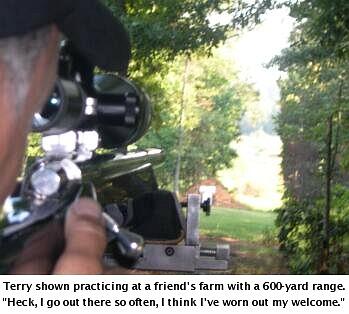 With the 6BR all I have to do is turn the necks, load and shoot. And you can fire-form during a match. A lot of boys shoot a match while fire-forming. With the 6BR all I have to do is turn the necks, load and shoot. And you can fire-form during a match. A lot of boys shoot a match while fire-forming.
Q: Any Advice for New Shooters?
A: Get good equipment. Find a good gunsmith. Pick a caliber with low recoil--that will get you back on the target quickly. Do a lot of practicing, and always shoot with windflags if possible.
I'm lucky because I've got a buddy with a 600-yard range on his farm. I go practice there all the time. In fact, I've probably just about worn out my welcome there. I work in a cardboard container place and on a white piece of cardboard you can see the bullet holes easy at 600 yards. |
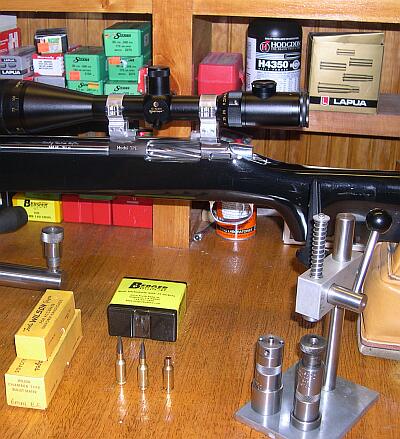 World-Record Recipe World-Record Recipe
Terry notes: "My record match load was 31.0 grains of Vihtavuori N540, with CCI 450 primers. I actually got this load from 6mmBR.com. The 600-yard competition page listed N540 as the favorite powder of Larry Isenhour, another Piedmont 6BR shooter. I did experiment with a number of powders: Varget, IMR 4895, N540, Reloader 15. The gun liked all the powders, but N540 produced the smallest groups. Second best was Varget, running about 2950 fps. I haven't chron'd the N540 load in a while but I think it's around 2900 fps.
I use Berger 105gr VLDs, with factory moly coating (it's just a mess if you coat them yourself). I started measuring the first 105s I bought, and they were very consistent so I quit measuring them, but I only have a couple boxes of the good bullets left. These are early California production, from a few years back, purchased from a local store. I hope the new ones are just as good. My seating depth is about .010" off 'max jam'. I figure that's about .015-.020" into the lands. Cartridge OAL is 2.383"; this has the shank (bearing surface) filling about 60% of the neck. [Editor's note: Dave Tooley used a separate throating reamer to cut the chamber, matching a dummy round. He estimates the freebore is about .120-.130".] As far as neck tension goes--I use a .263" Wilson bushing on a neck that's .266 with bullet in place."
Reloading Procedures--Keeping It Simple
Terry doesn't employ any exotic reloading methods: "I weight-sort the brass to start with, then I very lightly uniform the primer pockets. I also uniform the flash-holes, but just enough to catch any burrs. Sinclair makes a good deburrer that doesn't oversize the flash-holes. Since my rifle has a .267" neck, I turn the cases to about .0115" neck-wall thickness for a .266" loaded round. This is a simple, one-pass operation. I understand the appeal of a no-turn chamber, but I don't think I would go to a no-turn neck in the future. It's just not a big deal to turn the cases when I'm relaxing or watching TV. I use a K&M neck turner with the carbide mandrel with doughnut cutter. This is a great tool, but you have to be careful when inserting the mandrel or you can score the necks on the inside. I use regular 3 in 1 Oil on the mandrel and I put a little grease on the cutter tip. I use a tooth brush to take the shavings off. After turning, I'll chamfer the neck mouths inside and out. I fire-form with a normal load and a bullet in place--usually during practice sessions.
I throw powder with an RCBS measure to 28-29 grains, then trickle up manually and weigh each charge with an RCBS 10-10 scale. Bullets are seated with a standard 6BR Wilson hand seater. After the rounds are fired I do a lot less work than many shooters. I don't tumble my brass. I just clean up the outside of the necks with "Never Dull", then I'll clean the inside of the necks with a nylon brush chucked in an electric screwdriver. I DON'T normally full-length size the cases. I simply neck-size using a Wilson bushing die. In fact, my 6BR match brass has NEVER been full-length sized after it was fire-formed. The brass that shot the record had six or seven firings on it, and the primer pockets are still good and tight.
I may have to full-length size pretty soon, and I have a Redding body die for that. But for now, neck-sizing only is working fine. As for trimming, every four or five firings I'll find the shortest case and trim them all to the same length. Most of the time they're within a couple thousandths--around 1.553". I don't anneal my cases--either during the case-prep process or after shooting the cases. I can see how annealing could help extend brass life, but again, it's extra work that doesn't seem necessary yet.
Barrel Cleaning Procedure
Since I shoot moly, my cleaning procedure is different than you'd use with naked bullets. I went to moly so I wouldn't have to clean during matches. Now I'll clean every two matches--about every 80 rounds. Here's the procedure: I put a patch of Kroil through the barrel, then wet another patch with Kroil, stroke it pretty good, then I dry patch it. Next I run a couple Montana X-Treme 50 BMG wet patches and I let that set for 5-10 minutes, then dry-patch the 50 BMG out. Then I put a little JB on a dry patch on a jag, and short-stroke about 6-8 inches of the throat area for about a dozen strokes. After that I push another Kroil-wetted patch through again, and then wet/dry patch to remove the JB residue. The last step it to run a patch with Kroil. This complicated process gets the barrel clean but I've found it may take a dozen or more shots to get the moly back in again so the gun shoots optimally. If somebody has a better/faster way to clean for moly bullets, that doesn't require so many fouling shots, I'm all ears."
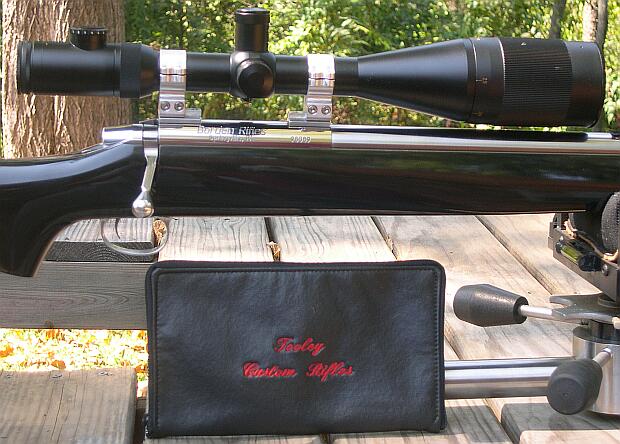
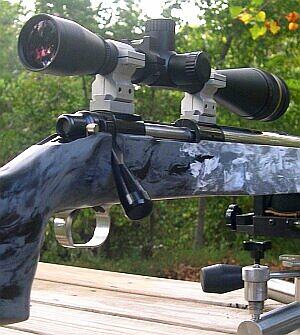 Terry's Other 'Race Gun' Terry's Other 'Race Gun'
Currently, Terry shoots his 15.5-pound 6BR in IBS "Heavy Gun" class, though it only weighs 15.5 pounds. He does this because HG rules prohibit muzzle brakes, and his "big boomers" have brakes. For Light Gun class, where muzzle brakes are allowed, Terry shoots his 17-pound 6.5-284. Smithed by Leonard Baity, the 6.5-284 features a blue-printed Rem 700 action (with Jewell trigger) pillar-bedded in a Shehane Fiberglass MBR Tracker stock. Next season Terry may replace the muzzle brake with a fitted cap so he can shoot the 6.5-284 in Heavy Gun.
Terry gives high marks to the MBR-style stock: "Most 6.5-284 shooters like to grip the stock a bit, to handle the recoil. The MBR Tooley, with its high comb and comfortable grip, gives me the option to use a little cheek weld and use some hand pressure. From my experience with my hunting guns, I'm accustomed to using some cheek contact and gripping the gun. The MBR lets you do that if you want. The stock also tracks great. The 6BR doesn't recoil as much as the 6.5-284, but if I was building a new 600-yard 6BR from scratch, I might just go with an MBR stock. I like how they shoot, and I think it would balance better with a 28" barrel than some of the ultra-low-profile short-range benchrest stocks. You can still shoot an MBR free recoil if you like, or just use a little thumb pressure, which is how I shoot the black record gun." In his 6.5-284, Terry uses H4350 powder (with Fed 210M primers) to push 140gr Berger VLD bullets through the 30" 8-Twist Krieger barrel. The scope is an older, fixed-power Leupold 36x with front-mounted adjustable objective. Terry observed: "It's a fine scope. Maybe Leupold should have stuck with the old 36x model. They seem to be more reliable than the side-focus models".
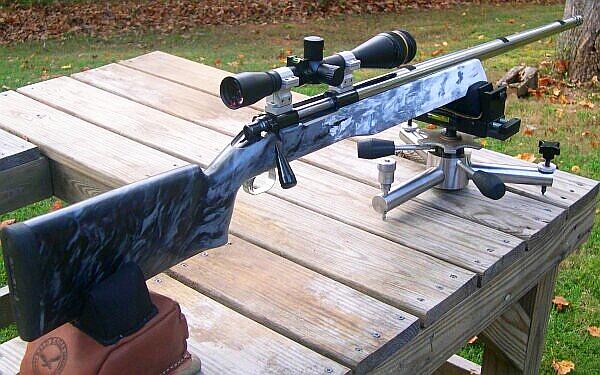 |
Did You Enjoy Reading this Article? If So, You Can Help Support
6mmBR.com by Making a Small, Secure Contribution.
Copyright © 2005, 6mmBR.com, All Rights Reserved. No reproduction of any content without advanced permission in writing.
Topics: 6mm, 6mm BR Norma, 6BR, 6BR Long, 6x44, 6x45, 6x47 Swiss, .308, IBS, NBRSA, 600 yards, 600-yard, Score, Group, Agg, Aggregate, Benchrest, 6mm Improved, Light Gun, LV, HV, 6PPC, Hart, Krieger, Terry Brady, Joel Kendrick, James Phillips, 300m, 600m, 1000 yards, Jewell, Benchrest, BR, Bench Rest, rifle accuracy, Recoil, Bipod, Parker-Hale, Wind, BC, Norma, Hodgdon Powder, Varget, H4350, Reloader, Vihtavuori, Lapua, Scenar, Competition Shooting, Stocks, Leupold, NightForce, Krieger, BAT, BAT Machines, Borden, barrel, reloading, powder, case forming, neck-turning, Lapua Brass, bullets, precision, Dave Tooley, Terry Leonard, Tom Meredith.

|